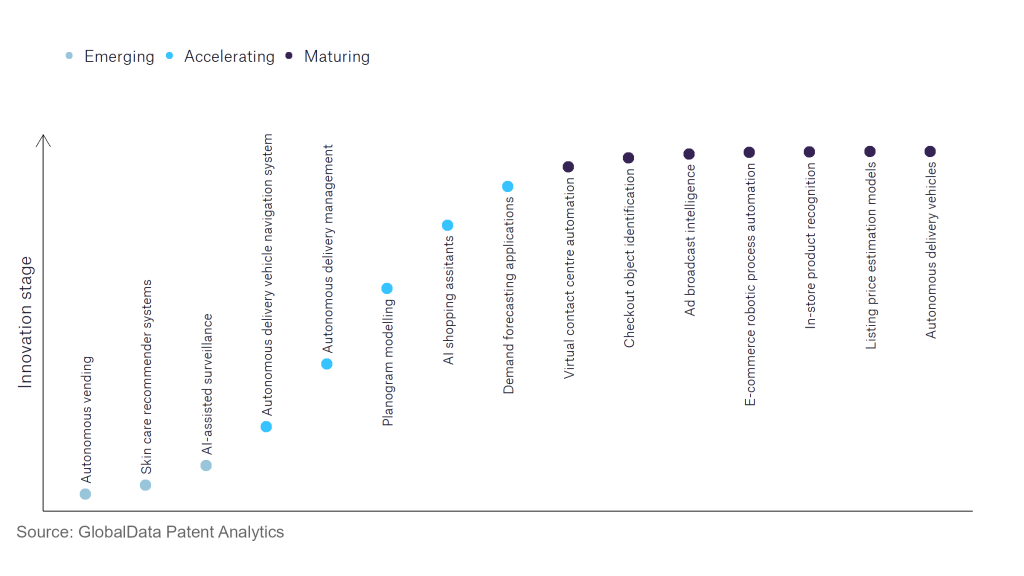The retail industry continues to be a hotbed of innovation, with activity driven by the need for operational efficiency and the growing importance of technologies such as autonomous vending, artificial intelligence, and machine learning. In the last three years alone, there have been over 133,000 patents filed and granted in the retail industry, according to GlobalData’s report on Artificial Intelligence: Demand forecasting applications. Buy the report here.
However, not all innovations are equal and nor do they follow a constant upward trend. Instead, their evolution takes the form of an S-shaped curve that reflects their typical lifecycle from early emergence to accelerating adoption, before finally stabilising and reaching maturity.
Identifying where a particular innovation is on this journey, especially those that are in the emerging and accelerating stages, is essential for understanding their current level of adoption and the likely future trajectory and impact they will have.
70+ innovations will shape the retail industry
According to GlobalData’s Technology Foresights, which plots the S-curve for the retail industry using innovation intensity models built on over 128,000 patents, there are 70+ innovation areas that will shape the future of the industry.
Within the emerging innovation stage, autonomous vending, skin care recommender systems, and AI-assisted surveillance are disruptive technologies that are in the early stages of application and should be tracked closely. Autonomous delivery vehicle navigation system, autonomous delivery management, and planogram modelling are some of the accelerating innovation areas, where adoption has been steadily increasing. Among maturing innovation areas are virtual contact centre automation and checkout object identification, which are now well established in the industry.
Innovation S-curve for artificial intelligence in the retail industry

Demand forecasting application is a key innovation area in artificial intelligence
With the help of machine learning algorithms, artificial intelligence-based demand forecasting applications can enable businesses to estimate their supply chain expenses and enable them to plan for seasonal product changes accurately. Using artificial intelligence, companies can monitor their entire supply chains from product sales to inventory turnover period.
GlobalData’s analysis also uncovers the companies at the forefront of each innovation area and assesses the potential reach and impact of their patenting activity across different applications and geographies. According to GlobalData, there are 30+ companies, spanning technology vendors, established retail companies, and up-and-coming start-ups engaged in the development and application of demand forecasting.
Key players in demand forecasting applications – a disruptive innovation in the retail industry
Leading companies in the AI-powered demand forecasting space in terms of patents filed are Strong Force Iot Portfolio, SoftBank Group, Pearson, EcoSense Lighting, and Capital One Financial. With an aim to enhance its AI-based analytics capabilities, Pearson acquired Faethm, a predictive analytics and workforce AI company, in September 2021.
Leading companies in this space in terms of application diversity are DataInfoCom USA, EcoSense Lighting, Winnow Solutions, and Strong Force Iot Portfolio.
Patent volumes related to demand forecasting applications
Source: GlobalData Patent Analytics
By means of geographic diversity, leading companies are Genetic Finance (Barbados), Winnow Solutions, Commonwealth Scientific and Industrial Research Organisation, and Tokyo Electron.
Demand forecasting using artificial intelligence has many benefits including optimised discounts and promotions, more operational efficiency, and happier customers.
To further understand the key themes and technologies disrupting the retail industry, access GlobalData’s latest thematic research report on Artificial Intelligence in Retail.
Data Insights
From

The gold standard of business intelligence.
Blending expert knowledge with cutting-edge technology, GlobalData’s unrivalled proprietary data will enable you to decode what’s happening in your market. You can make better informed decisions and gain a future-proof advantage over your competitors.



